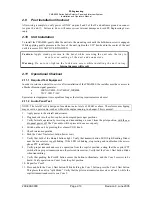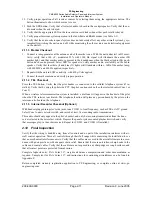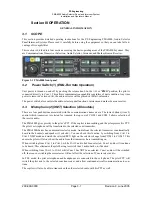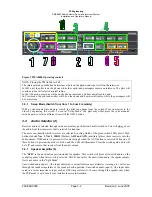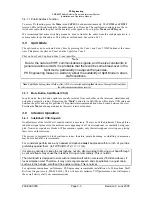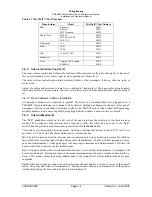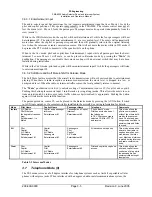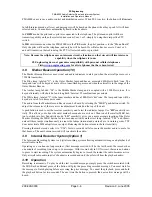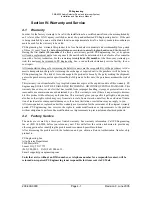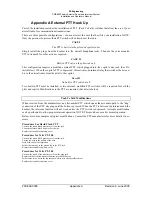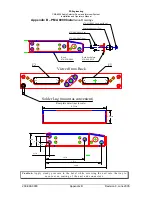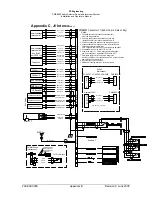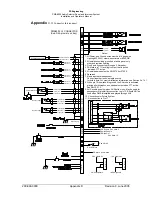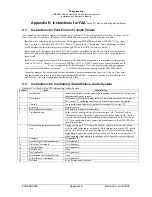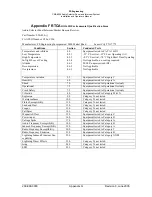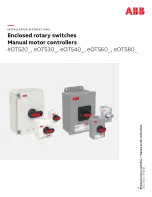
PS Engineering
PMA8000 Series Audio Selector Panel and Intercom System
Installation and Operator’s Manual
200-890-0000
Page 2-11
Revision 9, June 2005
12. Verify proper operation of all receiver sources by selecting them using the appropriate button. The
button illuminates to show which source is in use.
13. Push the SPR button. Verify that all selected audio is heard in the cockpit speaker. Verify that the au-
dio mutes when the mic is keyed.
14. Verify that the appropriate LED in the lower button row blinks when either push to talk is keyed.
15. Verify proper Intercom system operation in the
A
LL
, I
SO
and
C
REW
modes (see Table 3-1).
16. Verify that the audio selector panel system does not adversely affect any other aircraft system by sys-
tematically switching the unit on and off, while monitoring the other avionics and electrical equipment
on the aircraft.
2.11.3 Marker Checkout
1. Connect a ramp generator at the antenna end of the marker coax. With the unit under test in HI sensi-
tivity, verify that a 160
µ
V, modulated 95% with 1300 Hz, signal will illuminate the amber (M)
marker light, and that marker audio is present in the headphones when the Marker Audio (M) push-
button has been depressed. Select SPR for speaker to verify marker audio availability on the cabin
speaker. Verify that the white (I) and blue (O) lights will illuminate within
±
3dB of the amber lamp,
with 3000 HZ and 400 Hz applied, respectively.
2. Repeat with the unit in LOW sensitivity, with 430
µ
Volts applied.
3. Connect the marker antenna and verify proper operation.
2.11.4 TEL Checkout
Press the TEL button. Verify that the pilot headset is connected to the cellular telephone system (if in-
stalled). Verify that by using the pilot side PTT, the pilot can transmit on the other selected radio (Com 1 or
Com 2).
When a wireless telecommunication system is installed, a dial tone will appear in the headset of the pilot
when the TEL selector is activated. The telephone function will place any person heard by the pilot on the
intercom, also heard on the telephone.
2.11.5 Internal Recorder Checkout (Optional)
With headset plugged into pilot’s side jacks, tune COM 1 to local frequency, such as FSS or ATC ground.
Select Com 1 on mic selector switch, and record at least five incoming radio transmissions.
This audio should only appear in the pilot’s headset, and only be incoming transmissions from the trans-
ceiver selected in the mic select switch. Depress the panel or yoke mounted playback switch, and verify
that messages play, in the order received. Repeat for COM 2, and COM 3 (if installed).
2.12 Final
Inspection
Verify that the wiring is bundled away from all controls and no part of the installation interferes with air-
craft control operation. Move all controls through their full range while examining the installation to see
that no mechanical interference exists. Verify that the cables are secured to the aircraft structure in accor-
dance with good practices, with adequate strain relief. Ensure that there are no kinks or sharp bends in the
cables and coaxial cables. Verify that the cables are not exposed to any sharp edges or rough surfaces, and
that all contact points are protected from abrasion.
Complete logbook entry, FAA Form 337, weight and balance computation and other documentation as
required. Sample text for FAA Form 337, and instructions for continuing airworthiness can be found in
Appendix F.
Return completed warranty registration application to PS Engineering, or complete online at www.ps-
engineering.com.














